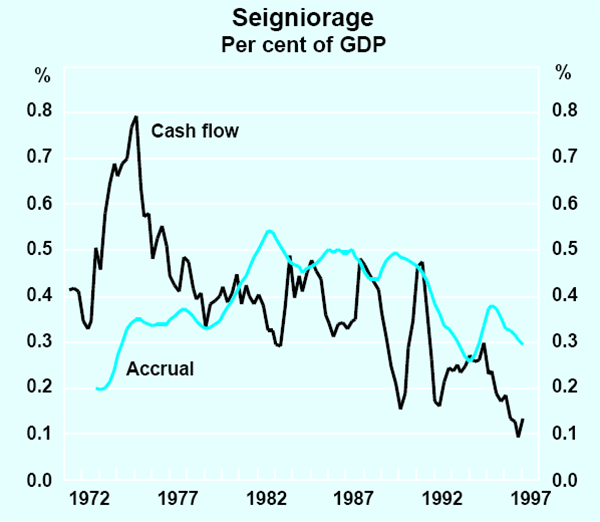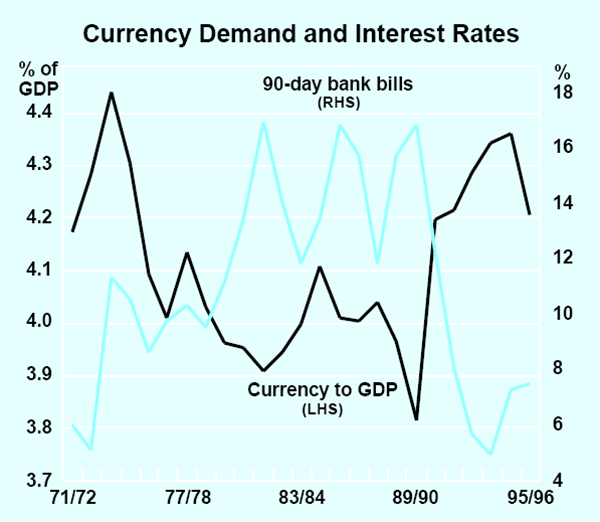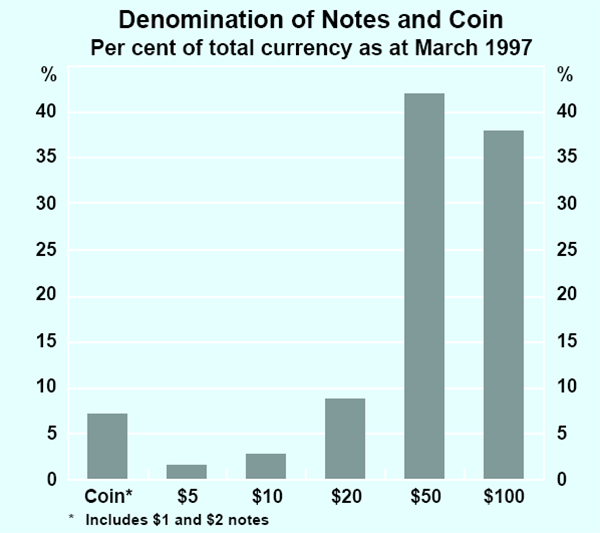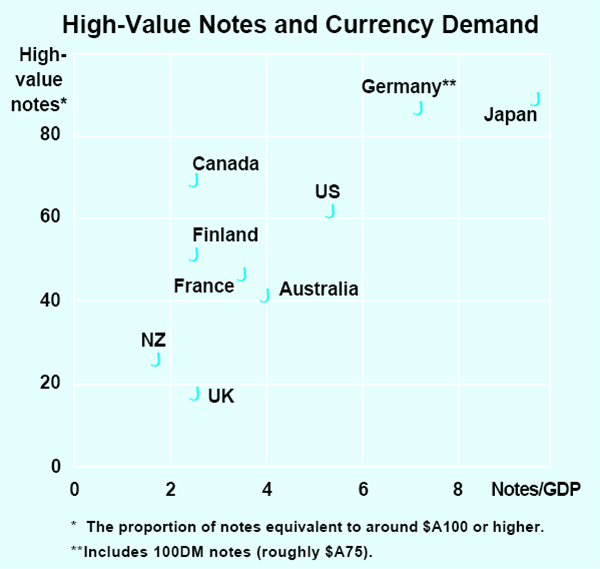Bulletin – July 1997 Measuring Profits from Currency Issue
Introduction
The Reserve Bank of Australia (RBA), like most central banks, issues the currency notes in general circulation, while the Commonwealth Treasury issues coin produced by the Australian Mint. The profits earned from the issuing of notes and coin are known as seigniorage, a term which has its roots in early times when such profits accrued to the seigneur, or ruler, who was responsible for issuing coin.[1] This article discusses the source of these profits, as well as the factors influencing recent trends in the amount of seigniorage earned in Australia.
The Origins and Measurement of Seigniorage
When a commercial bank requires additional notes to meet the needs of its customers it buys those notes from the RBA. The bank pays for these notes by providing the RBA with another financial asset – such as a government security – the value of which is equal to the face value of the notes.[2] Seigniorage arises because the cost of producing the notes is much smaller than the value of the asset received by the RBA.
There are two approaches to measuring seigniorage. The first directly compares the face value of increases in the stock of currency with the costs of producing the currency; these costs include the costs of replacing worn-out notes. Using this measure – sometimes known as the ‘cash-flow’ approach – the profits from currency issue are recorded at the time that the currency enters circulation; this is the practice used to account for the seigniorage earned by the Treasury from the coin issue. The second approach treats currency as a liability of the issuer, and measures the flow of income from the assets held by the issuer as a result of the currency issue (less production costs). Because currency notes are frequently returned, cancelled and re-issued, this ‘accrual’ or ‘liability’ approach is the preferred approach to measuring seigniorage from note issue and is used by the RBA. This approach results in a flow of profits over time. Over long periods the two approaches should yield similar estimates of seigniorage if the rate of increase in notes on issue is similar to the rate of return earned by the central bank on its assets. Seigniorage is included in the Bank's overall profits, which are paid to the government.
Central banks have liabilities other than currency. At present, currency notes account for slightly less than half the RBA's total liabilities, with deposits from governments and banks accounting for around one-third of total liabilities. The net returns earned by the Bank from investing these deposits should not be included in estimates of seigniorage, as these earnings arise from central-bank functions unrelated to note issue.
Graph 1 shows two estimates of seigniorage from note issue expressed as a ratio to GDP. For the accrual measure, the yield on 5-year bonds has been used to proxy the rate of return earned by the Bank on its assets; the actual rate of return is volatile from year to year and complicates the interpretation of underlying trends. Production costs have been excluded from both measures; including them would make no discernible difference. Both measures are only broad approximations with more precise calculations depending upon a range of accounting practices and assumptions regarding which of the Bank's assets were purchased with the proceeds of currency issue.

Over recent years, seigniorage from note issue has averaged 0.3 per cent of GDP using the accrual approach and 0.2 per cent of GDP using the cash-flow approach. Both inflation and nominal rates of interest will influence these measures of seigniorage (see below), although the influence will differ between the two measures. As a share of GDP, seigniorage is considerably below the levels earned in the 1980s when inflation and nominal interest rates were much higher. While the accrual estimate tends to be smoother, the two estimates of seigniorage have been broadly similar for much of the period although there are marked differences in the 1970s. These differences arise from the fact that the increase in inflation in the 1970s led to a rapid increase in the community's nominal demand for currency, but bond yields did not rise fully in line with inflation, at least not at first. As a result, the cash-flow measure shows a much larger increase in the mid 1970s than does the accrual measure. In recent years, the reverse has been the case as inflation has fallen faster than bond yields.
The seigniorage earned on coin issue is considerably less than that earned on notes as the value of coin outstanding is currently around $1.5 billion compared with around $20 billion in notes outstanding. Over the 1990s seigniorage from coin has averaged between 0.01 and 0.03 per cent of GDP – or $50 million to $150 million per year.
By international standards, total seigniorage in Australia is neither particularly high, nor particularly low (Table 1). The United States, Japan and Germany stand out on the high side. Figures for the US and Germany primarily reflect the large amounts of their currencies held offshore. The US Federal Reserve estimates that in excess of 50 per cent of total currency in circulation is held outside of the US. In part this is the result of countries such as Panama and Liberia using US currency as their own currency, and, more importantly, the use of the US dollar as a partial substitute for domestic currency in a number of countries in which the public has less than full confidence in the local currency. Similarly, in Germany, the Bundesbank estimates that between 30 and 40 per cent of Deutsche marks are held abroad. Japan also has very high holdings of currency. New Zealand, on the other hand, stands out at the low end of the scale.
| Country | Seigniorage Per cent of GDP |
|---|---|
| United States(b) | 0.43 |
| Germany | 0.50 |
| Japan | 0.46 |
| United Kingdom(b) | 0.17 |
| New Zealand(b) | 0.06 |
| Australia | 0.22 |
|
(a) Average ‘cash-flow’ measure (b) Data end in 1995 |
|
Factors Influencing the Demand for Currency
The amount of seigniorage earned depends upon the size of the public's currency holdings. Of the many factors that influence these holdings, perhaps the three most important factors over recent years have been:
- the rate of inflation;
- changes in the use of currency as a store of wealth; and
- changes in the use of currency for transactions purposes.
Inflation
As the nominal value of GDP rises, the public's demand for currency tends to increase also; higher volumes of production lead to an increase in currency demand, as do higher prices. This means that seigniorage tends to increase as the inflation rate increases – on the cash flow measure because the size of the annual change in currency on issue increases, and on the accrual measure because nominal interest rates increase as inflation rises.
This link between inflation and seigniorage has seen some (usually less-developed) countries run very high rates of inflation in an attempt to finance government expenditure through seigniorage, rather than direct taxation. Such an approach has typically been self-defeating and led to hyper-inflation. When the inflation rate increases to very high levels, the public go to considerable effort to reduce their holdings of currency as a ratio to their income. This ratio can fall to such an extent that despite the high rate of currency increase associated with high inflation, seigniorage begins to fall as a share of nominal GDP. This creates budgetary problems and can lead to an accelerating inflation rate.
Clearly, this situation has never occurred in Australia. In fact, the decline in inflation in Australia in the early 1990s has led to a fall in seigniorage. In the 1980s, the average inflation rate was over 8 per cent and the cash-flow measure of seigniorage averaged around 0.4 per cent of GDP. In contrast, since December 1991 the inflation rate has averaged 2.3 per cent and this measure of seigniorage has fallen to average just 0.2 per cent of GDP. Similarly, the decline in nominal interest rates that has accompanied the fall in inflation has seen the accrual measure of seigniorage fall in the 1990s.
Currency as a store of wealth
The value of notes and coin outstanding as a share of GDP increased markedly in the first half of the 1990s and is currently just below its highest point in the past twenty years (Graph 2). While lower inflation has made it less costly to hold wealth in currency, regulatory and taxation factors also may have increased the demand for currency. New laws – including the requirement on financial intermediaries to report large transactions to the Cash Transaction Reports Agency, requirements for more stringent identification of depositors, and the deeming of interest for the means test on pensions – may have encouraged some people to hold more of their wealth in cash.

An indication of the important role that currency plays as a store of wealth is given by the high proportion of notes of $100 denomination (Graph 3). Almost 40 per cent of the value of currency in Australia is accounted for by ‘hundreds’. Because $100 notes are used relatively infrequently for normal daily transactions, it follows that many of these notes are used for other purposes – for example, as a store of wealth or for transactions in the ‘cash or underground economy’. Consistent with the idea that currency is being hoarded as a store of wealth is the fact that notes of $100 denomination appear to circulate less frequently than other notes; on average a $100 note returns to the RBA once a year, in contrast to ‘twenties’ which return over five times a year.

Australia is not unusual in having a large proportion of its notes in high-value denominations. Graph 4 plots the ratio of notes to GDP and the proportion of high-value notes – notes which are the equivalent of around $A100 and higher – for a number of countries. While cultural differences are clearly important in explaining currency demand, the positive relationship between the demand for currency notes and the proportion of high-value notes suggests that hoarding motives may be fundamental in understanding the pattern of currency demand across countries.

Transactions demand for currency
Currency remains the medium of exchange for most small transactions. However, technological change is leading to the progressive implementation and acceptance of an increasing variety of electronic forms of payments. For example, in most firms, first cheques, then the direct crediting of bank accounts, have replaced the cash payment of wages and salaries. More broadly, the values of payments by credit and debit cards have increased at annual rates of 26 and 34 per cent respectively over the past two years.
Consistent with the decline in the relative importance of currency as a transactions medium is the fact that the value of notes of low denomination (5s, 10s, 20s and 50s) as a percentage of total spending is now lower than it was ten years ago.